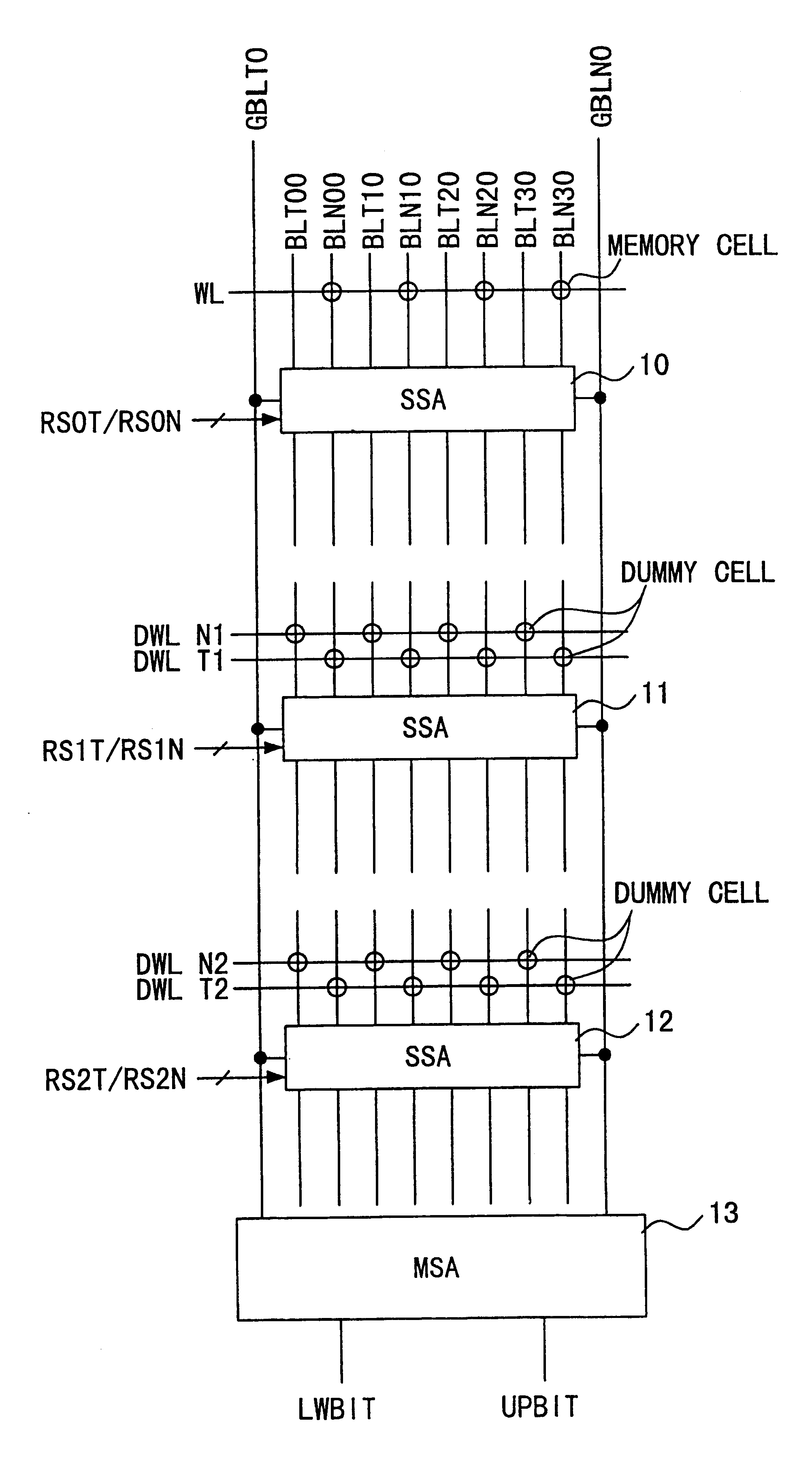Semiconductor memory device
a memory device and semiconductor technology, applied in the field of semiconductor memory devices, can solve the problems of increasing cost, affecting the actual product, and extending the permissible range of capacitance variance,
- Summary
- Abstract
- Description
- Claims
- Application Information
AI Technical Summary
Problems solved by technology
Method used
Image
Examples
first embodiment
FIG. 1 is a block diagram showing the structure of the essential elements of a DRAM according to the first embodiment, and like the first example of conventional art, is drawn by extracting only the parts related to the memory cell and sense amplifiers. For circuits other than those illustrated, circuits having the same functions as a circuits provided with a typical multi-value DRAM can be used. In addition, the memory cell array of the DRAM is formed by being partitioned into a plurality of sub-arrays, and in this figure, among the plurality of sub-arrays, only the three sub-arrays activated when carrying out the reading / writing of the memory cells included in specific sub-arrays are shown.
In the DRAM in each of the embodiments of the present invention, the example of a structure wherein a layered bit line structure is used, and it is assumed that one pair of complementary bit lines and 4 pairs of complementary sub-bit lines are treated as a unit. Metal wiring such as aluminum is ...
second embodiment
In the above-described first embodiment, while three stages of sensing are carried out in order to read the multi-level data stored in a memory cell, theoretically, by providing three the MSAs for each of SSAs, reading with a one-stage sensing is possible. However, if this structure is implemented, not only does the printing of the main bit lines become physically problematic, the disposition of the MSAs also becomes troublesome. Thus, it is difficult to say that such a method can be realized. Therefore, in the present embodiment, the three-stage sensing carried out in the first embodiment is reduced to two-stage sensing, and the operation time can be reduced without making the structure excessively complicated.
FIG. 8 is a block diagram showing the structure of the essential elements of the DRAM according to the present embodiment, and structures that are identical to those shown in FIG. 1 (the first embodiment) have identical reference symbols. As shown in the figure, in the presen...
third embodiment
In the above-described second embodiment, sensing is carried out essentially in two stages, but in the present embodiment, by carrying out the sensing in one stage, the operating time can be further reduced. FIG. 13 is a block diagram showing the structure of the essential elements of the DRAM according to the present embodiment, and essential elements of the structure that are the same as those shown in FIG. 8 (the second embodiment) have the same reference symbols. In the present embodiment, twice as many sub-arrays, SSAs, and main bit lines are used as those in the second embodiment, and at the same time, four times as many the MSAs are used as in the second embodiment to carry out access of the memory cells.
Thus, in the present embodiment, for one word line WL, 4 pairs.times.4=16 pairs of sub-bit lines intersect, and 16 memory cells are disposed where they intersect. Similarly, for the dummy word lines DWLT and DWLN, 16 sub-bit lines intersect, and 16 dummy cells are disposed wh...
PUM
 Login to View More
Login to View More Abstract
Description
Claims
Application Information
 Login to View More
Login to View More - R&D
- Intellectual Property
- Life Sciences
- Materials
- Tech Scout
- Unparalleled Data Quality
- Higher Quality Content
- 60% Fewer Hallucinations
Browse by: Latest US Patents, China's latest patents, Technical Efficacy Thesaurus, Application Domain, Technology Topic, Popular Technical Reports.
© 2025 PatSnap. All rights reserved.Legal|Privacy policy|Modern Slavery Act Transparency Statement|Sitemap|About US| Contact US: help@patsnap.com



